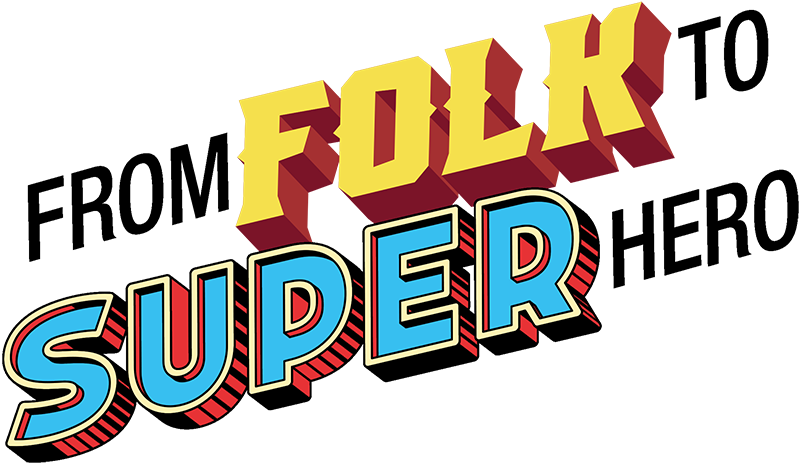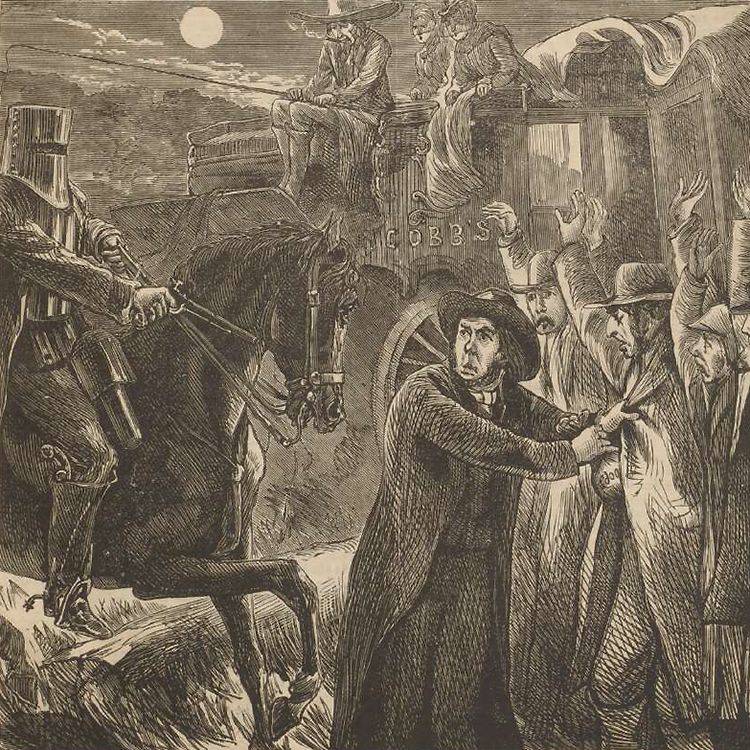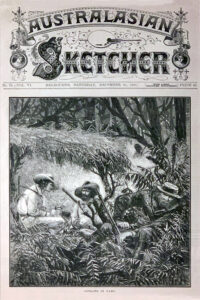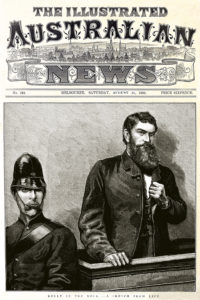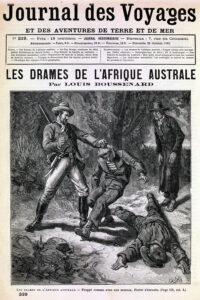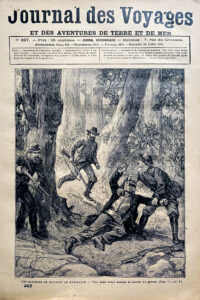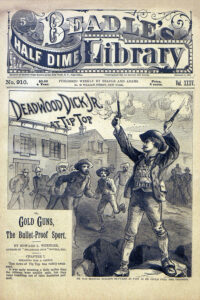ILLUSTRATIVE TEXT
19th CENTURY
We have no hesitation in saying that the life of Ned Kelly, the Ironclad Bushranger, is as disgraceful and disgusting a production as has ever been printed. Lord Campbell’s Act recognised the moral mischief which might be done by publications which offend against common decency, and provided for the condign punishment of the scoundrels who write print and sell them — they are, as the annals of the police courts prove every day, direct incentives to murder and robbery.
Saturday Review of Politics, Literature, Science and Art
26 November 1881
This section examines 19th century illustrated news, story papers, penny dreadfuls [or bloods], and nickel and dime novels, whose notions explore aspects of Ned Kelly folklore. From his rebellious spirit and defiance of authority to the iconic imagery of his armour, Ned’s narrative has permeated our artistic awareness and influenced popular culture at a conscious and subconscious level. These colonial representations would affect the origin stories of several modern-day superheroes [and villains] manifesting themselves through diverse reincarnations and reinterpretations.
- 1878
The Australasian Sketcher
 Issue: #74
Issue: #74
Publisher: Hugh George
Printer: Webb, Vardon and Pritchard
Date: 23 November 1878
Type: Story PaperThe wood engraved illustration appeared on the front cover with the title, The Bush Ranging Tragedy: portraits of the four Constables and the two Kellys. 1 – Constable Lonigon, 2 – Edward Kelly, 3 – Constable Scanlan, 4 – Sergeant Kennedy, 5 – Constable M’Intyre, 6 – Daniel Kelly. The Australasian Sketcher was first published in Melbourne in 1873.
In its early years, the paper had a marked literary content [short stories, sketches, reviews] but later became an illustrated news magazine. Illustrations generally appeared on the front cover and in three double-page spreads. Columns covered theatre, the arts, sports, and serialised stories. Several articles during the late 1870s describe and portray the Kelly Gang and, in 1880, their capture through July and August and the trial and execution of Ned Kelly in November.
- 1878
The Illustrated Australian News
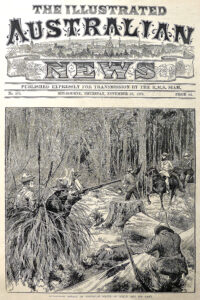 Issue: #270
Issue: #270
Creator: Ebenezer and David Syme
Publisher: David Syme
Date: 28 November 1878
Type: Story PaperThe front page caption reads, ‘Murderous attack on Victorian Police by Kelly and his Gang.’ The wood engraved illustration depicts the killing of Sergeant Michael Kennedy and Mounted Constable Michael Scanlon by the Kelly Gang at Stringybark Creek on 25 October 1878.
- 1878
- 1880
The Illustrated Australian News
 Issue: #291
Issue: #291
Creator: Ebenezer and David Syme
Publisher: David Syme
Date: 3 July 1880
Type: Story PaperThe wood engraved illustration appeared on the front cover with the title, The murder of Sherritt. From a sketch taken immediately after the departure of the Kelly Gang. The Illustrated Australian News was a monthly news magazine of record in Melbourne. Its publishers, brothers Ebenezer and David Syme, also held the controlling interest in The Age newspaper. The Illustrated’s final edition was released at the start of May 1889.
- 1880
The Australasian Sketcher
Issue: #101
Publisher: Hugh George
Printer: Webb, Vardon and Pritchard
Date: 10 July 1880
Artist: Thomas Carrington
Type: Story PaperThe wood engraving appeared on the front cover with the title Ned Kelly at Bay, from a sketch drawn on the spot by Mr. T. Carrington. This illustration is Carrington’s most famous image from the siege of Glenrowan and has become an icon. Having travelled in the special police train from Melbourne, the artist was approximately one hundred metres away from the confrontation and unaware that the outlaw’s coat was draped over his shoulders. However, Carrington’s depiction of Ned’s stance, his helmet, the revolver, and Kelly’s wounded left arm is highly accurate.
Presently we noticed a very tall figure in white stalking slowly along in the direction of the hotel. There was no head visible, and in the dim light of morning, with the steam rising from the ground, it looked, for all the world, like the ghost of Hamlet’s father with no head, only a very long, thick neck.
Thomas Carrington
- 1880
The Illustrated Australian News
- 1880
The Australasian Sketcher
Issue: #102
Publisher: Hugh George
Printer: Webb, Vardon and Pritchard
Date: 24 July 1880
Artist: Thomas Carrington
Type: Story PaperThe wood engraved illustration appeared on the front cover with the title, The Destruction of the Kelly Gang: Scene at the wake at Greta. As the ceremony was held privately with select family and friends in attendance, no actual reporter or artist was present at the funeral, so the illustration was entirely contrived.
- 1880
The Australasian Sketcher
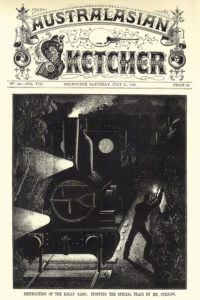 Issue: #103
Issue: #103
Publisher: Hugh George
Printer: Webb, Vardon and Pritchard
Date: 31 July 1880
Artist: Thomas Carrington
Type: Story PaperThe wood-engraved illustration appeared on the front cover with the title Destruction of the Kelly Gang: Stopping the Special Train by Mr. Curnow. The artist, Carrington, rode with a press contingent in the police special, which was a few hundred metres behind the pilot locomotive when it was stopped just outside Glenrowan by the local school teacher Thomas Curnow.
The figure staggered and reeled like a drunken man, and in a few moments afterwards fell near the dead timber. The spell was then broken, and we all rushed forward to see who and what our ghostly antagonist was […] the iron mask was torn off, and there, in the broad light of day, were the features of the veritable bloodthirsty Ned Kelly himself.
Thomas Carrington
- 1880
The Australasian Sketcher
- 1880
The Illustrated Australian News
Issue: #294
Creator: Ebenezer and David Syme
Publisher: David Syme
Date: 28 August 1880
Artist: Julian Ashton
Type: Story PaperThis engraved illustration was copied from an impressive watercolour by Julian Ashton and appeared on the front cover with the title, Kelly in the dock – a sketch from life. The cover also carries the incorrect edition of #292.
Ned had been suspicious of Ashton’s reasons for painting him and, after being given a possum rug to keep him warm in the icy courtroom, he raised it across one arm to screen his face from the artist.
Ian Jones Ned Kelly: The Last Stand
- 1880
McGee's Illustrated Weekly
Issue: Vol. 7 #47
Creators: James A. McGee, Maurice Francis Egan
Location: New York, N.Y.
Date: 9 October 1880
Type: Story PaperThe front page of the New York-based McGee’s Illustrated Weekly from 9 October 1880 highlights two half-page illustrations showing the last stand of the infamous Kelly Gang at Glenrowan, Victoria, in which Ned the bushranger, dressed in his homemade armour, defended himself against an insurmountable army of policemen. The top illustration shows Ned in a ‘grove of trees’, surrounded by a trio of policemen aiming their guns, as he stands dressed in his armour, with a ‘sort of protective visor over his face’. At night, the lower illustration shows the Glenrowan Hotel with figures firing from the front porch in the dark.
On page two, there is a 9 1/2 inch column article under the title, The Kelly Gang of Bushrangers. It includes the following description, ‘One of the most peculiar features of the case is, that the robbers had provided themselves with armor made out of plows, which weighed about 97 pounds per man, and which proved for a time very effective. When one of the constables saw Edward Kelly approaching in this singular guise, he thought he was a madman come out to take part in the siege, while others declared he was the devil, or the bunyip, a fabulous creature supposed to haunt the interior of the country.’
It is interesting to note the helmet’s incorrect orientation, repeated numerous times in other illustrations [see timeline below]. John F. Nash originally illustrated the inverted helmet in The Graphic on 4 September 1880. The incorrectly composed drawing was based on the police photograph by Oswald Madeley. That photo shows Ned’s helmet resting on its crown [upside down] next to segments of the Gang’s armour.
- 1880
The Australasian Sketcher
Issue: #110
Publisher: Hugh George
Printer: Webb, Vardon and Pritchard
Date: 6 November 1880
Type: Story PaperThe title of the front cover engraving reads, The Trial of Edward Kelly, the Bushranger. It depicts Ned in the dock of the Supreme Court in Melbourne looking across at the trial judge, Redmond Barry.
- 1880
The Australasian Sketcher
Issue: #111
Publisher: Hugh George
Printer: Webb, Vardon and Pritchard
Date: 27 November 1880
Artist: Thomas Carrington
Type: Story PaperCarrington’s front cover engraving title reads, Last scene of the Kelly drama: the criminal on the scaffold. While the artist was not an official witness at the hanging, he could have worked from a sketch supplied by his friend Joe Melvin from the Argus and his drawing of the gallows area.
- 1881
Ned Kelly: The Ironclad Australian Bushranger
Issue: #1
Creator: James Skipp Borlase
Publisher: Alfred J Isaacs and Sons
Published: 1881
Format: Penny Dreadful
Extent: 12 pagesThis is issue one of a weekly thirty-eight-part penny-blood series originally published in 1881. The publisher, Alfred Isaacs, was not a huge printer of penny dreadfuls; in fact, The Ironclad Australian Bushranger was their only known title.
We have no hesitation in saying that the life of Ned Kelly, the Ironclad Bushranger, is as disgraceful and disgusting a production as has ever been printed. Lord Campbell’s Act recognised the moral mischief which might be done by publications which offend against common decency, and provided for the condign punishment of the scoundrels who write print and sell them — they are, as the annals of the police courts prove every day, direct incentives to murder and robbery.
Saturday Review of Politics, Literature, Science and Art
26 November 1881View: Ned Kelly: The Ironclad Australian Bushranger [covers]
- 1883
Journal des Voyages
Issue: #329
Publisher: Revue des Deux Mondes
Published: 28 October 1883
Format: Story PaperStory: Une Histoire De Bandits En Australie [5 pages]
Artist: Joliet After CastelliThe #329 edition of the French magazine Journal de Voyages featured the story Une Histoire De Bandits En Australie which ran over five pages and included a double page wood engraving titled Miss Kelly venait d’apparaitre dans son costume legendaire. The illustration depicts a distinctly Gallic Kelly Gang [their helmets adorned with horns] along with Ned’s sister Kate sporting a Musketeer’s plumed hat.
Information: Gallica.bnf.fr
View: Miss Kelly venait d’apparaitre dans son costume legendaire [image] - 1884
Journal des Voyages
Issue: #367
Publisher: Revue des Deux Mondes
Published: 20 July 1884
Format: Story PaperStory: Les batteurs de buissons en Australie
Artist: Joliet After CastelliThe #367 edition of the French magazine Journal de Voyages features the story Les batteurs de buissons en Australie – Une balle avait atteint le bandit au genou on Page 34 [Column 3]. Roughly translated to Bush beaters in Australia – A bullet had hit the bandit in the knee, the front page wood engraving by the artist Castello reproduces Ned’s mistaken headdress [with its incorrect orientation].
Information: Gallica.bnf.fr
- 1895
Beadle's Half Dime Library
Issue: #910
Publisher: Beadle and Adams
Published: 1 January 1895
Format: Nickle & Dime
Extent: 16 pagesStory: Gold Guns, The Bullet-Proof Sport
Author: Edward L. WheelerWith its lower price point of 5¢, Beadle’s Half-Dime Library was intended to appeal more to children than adults. Albert Johannsen (The House of Beadle and Adams and its Nickel and Dime Novels) claims that this is also why the type is so tiny: “Beadle evidently figured that a boy’s eyesight was good, and that he would prefer having a lot of reading matter for a nickel than to have less in more readable type.” It also ran as long as that earlier series, making it the second longest-running series published by Beadle. Each number contains a complete story, although several also include short stories or parts of serialized stories. Frontier and Western stories predominate, although those about detectives and criminals are much more common towards the end of the series. Major recurring characters include Deadwood Dick, Broadway Billy, Buffalo Bill, and New York Nat.
I would give a good deal to know that secret, for such a suit must be invaluable.
Yes, but a nuisance to Wear. It is by far too heating, and I intend to lay it off pretty soon and take my chances without it for the future.
Then you do not attach much value to it.
On the contrary, it is worth big money, if rightly handled. An army wearing such bullet-proof garments would be simply invincible. My friend will introduce it in that direction as soon as he perfects it.
Link: DimeNovels.lib.niu.edu
Note: The comic section is an ongoing project and we are constantly searching for additional content. If you have any information which may be of benefit or is missing from this component, please contact us at enquiry@folk2super.com. All enquiries are welcome.
